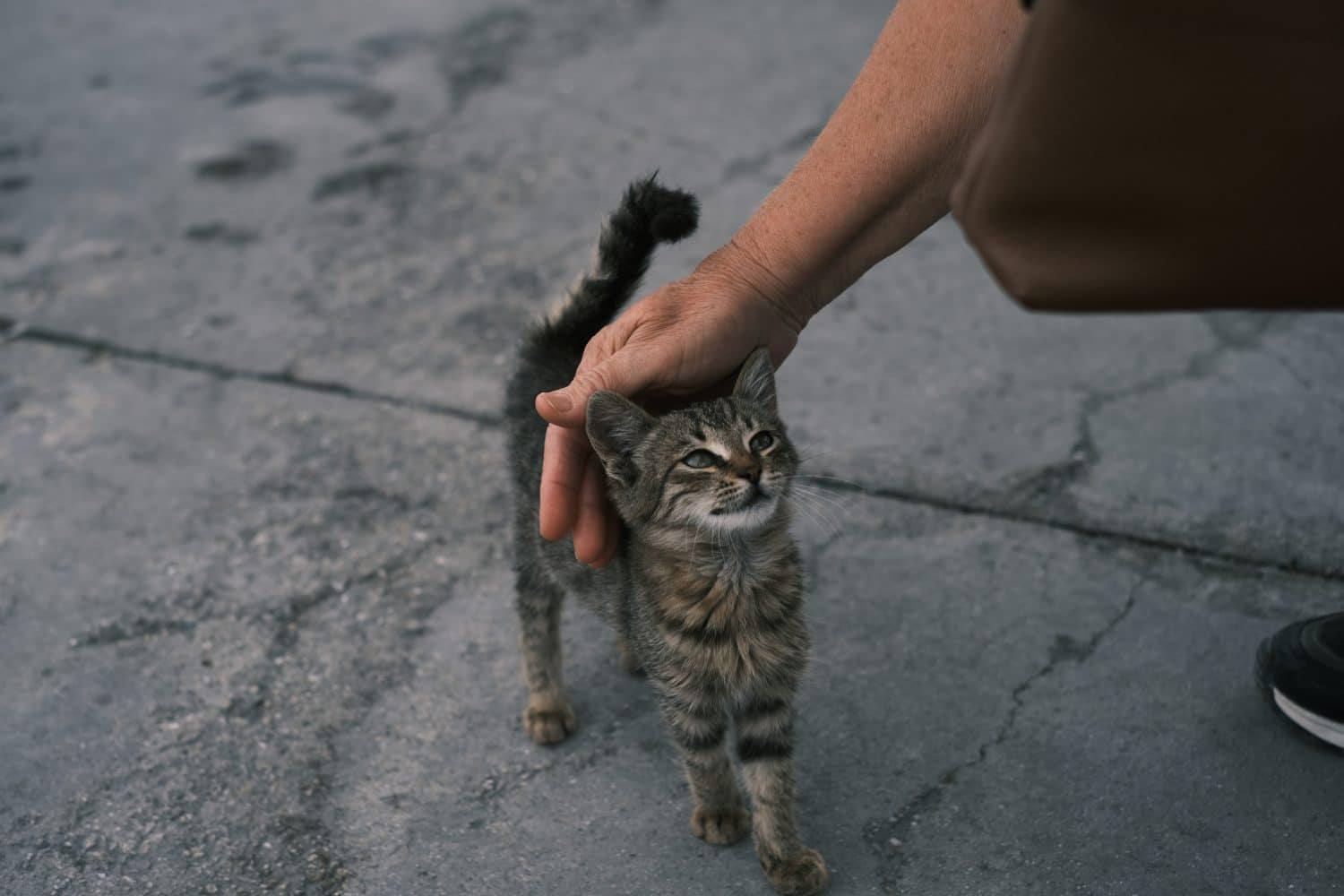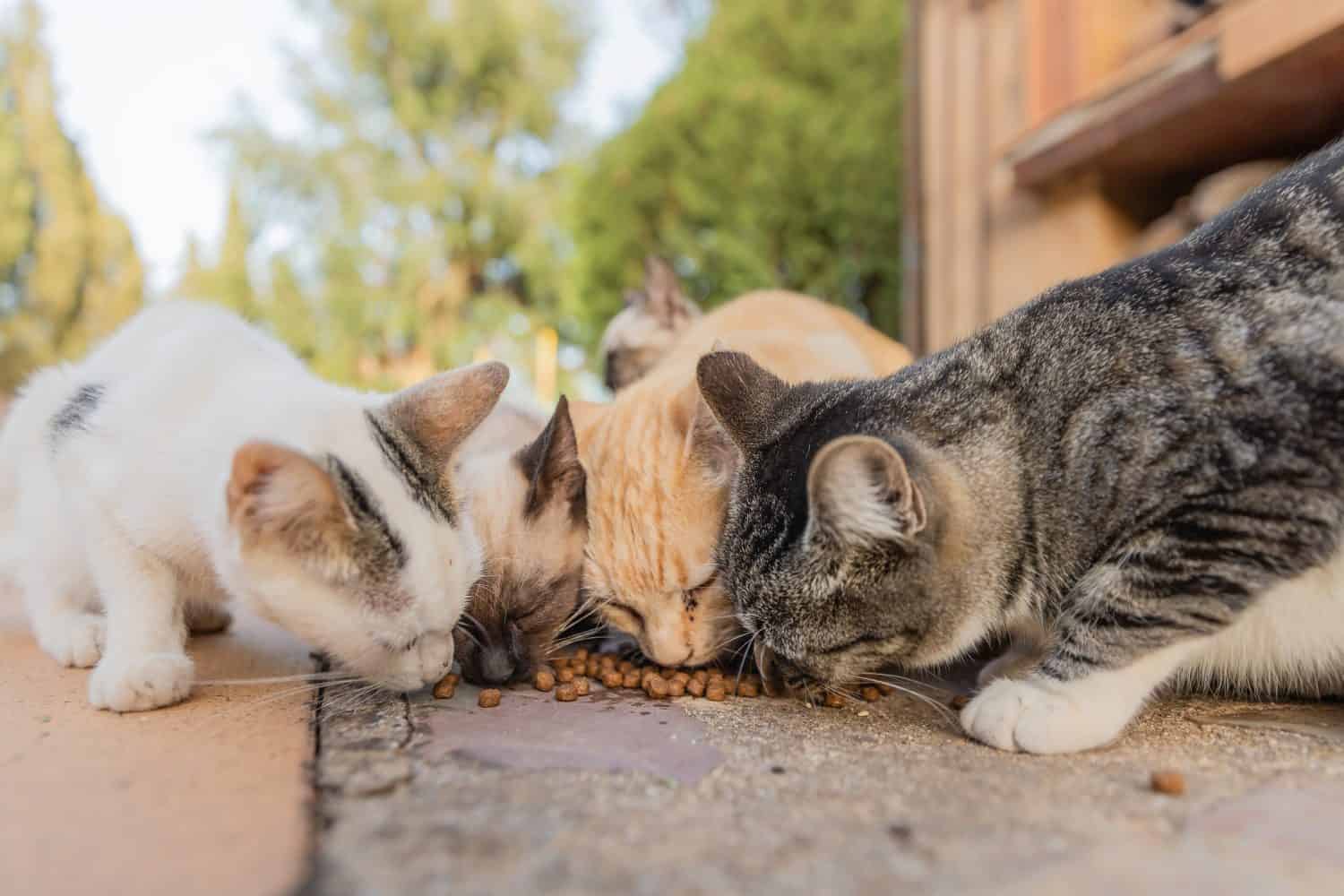Let’s be honest, most of us cat-lovers have seen a stray walking around and wished we could go over and pet the little cutie. However, it’s not often that easy. Even though some stray cats might be social and friendly, not all of them are trusting of humans. Because of this, it’s important we make them feel comfortable and not rush them into an interaction. Here are six steps that will make a huge difference when befriending a stray cat.
1. Crouch Down When Approaching a Stray Cat

It is estimated that there are over 480 million stray cats worldwide.
©Imaginary Owl/Shutterstock.com
Even though we mean no harm, to cats, we might be scary. Combined with their general lack of trust, cats can be fearful of an approaching, seemingly giant, human. Because of this, the first thing to do is crouch down to appear smaller and less intimidating. Slow and steady is the best strategy here, so try not to get too close before crouching. In fact, staying a few feet away and extending your arm is a great way to say, “I’m friendly!”
2. Offer Your Hand So They Can Learn Your Smell

Stray cats are social animals, and many live in colonies.
©movchanzemtsova/Shutterstock.com
After getting down to eye level with a stray cat, extend your hand slowly so that they can take a sniff. They might not take you up on the offer, but if they do, this will help build trust and give them a sense of who you are. Unlike people, animals have a keen sense of smell. According to PAWS Chicago, “A cat’s sense of smell is the primary way he identifies people and objects. Cats have more than 200 million odor sensors in their noses; humans have just five million. Their sense of smell is 14 times better than that of humans.” Once they learn your scent, they’ll be able to associate it with a friendly presence.
3. Provide Stray Cats With Food

In order to ensure survival, stray cats develop keen hunting skills. But they benefit from human kindness.
©Natalia de la Rubia/Shutterstock.com
One thing is for sure, stray cats usually don’t know where they’ll find their next meal. Offering them some kibble, cat treats, or even better, wet food, can be an easy and quick way to ensure your status as “friend.” They say the way to someone’s heart is through their stomach, and with stray kitties, that’s especially true. Almost any brand can benefit a stray, so try not to overthink it. They’ll even take tuna straight from the can! Make sure you leave their food in the same area each day. This will help them to associate that spot with free meals. At first, you can watch from a distance while they enjoy their dinner. As time passes, it’s okay to get closer and closer as you establish trust.
4. Give Them Personal Space

Many stray cats appreciate being left alone, coming to you if they so choose.
©Oxana Oliferovskaya/Shutterstock.com
As we stated earlier, it’s important to take cues from the stray cat and let them take the lead. Rushing to approach them when they’re not ready can result in a breach of trust. If this happens, it can undo any progress previously made. Cats are very smart animals, and strays can be especially cautious and distrustful around people that they don’t know well. The last thing you want to do is go backward in time, as the process of befriending a stray is already very slow going. That being said, it’s important to never pet or touch them when it’s unwanted. Let the cat initiate any contact.
5. Interact With Them Frequently

TNR (
trap, neuter, release
) is a process that aims to keep feral cat populations under control.
©evgenii mitroshin/Shutterstock.com
When it comes to befriending strays, consistency is key. The more effort you put into interacting with the strays, the higher the likelihood is that they’ll remember you. If you come often, bring food, and act friendly and approachable, they’re sure to think of you as someone safe and kind. However, if you take long breaks in between visits, it might cause the cats to forget all the good you’ve done. Or even worse, your kitty friends may begin to think that you’ve forgotten about them, especially if you neglect to give them food that they’ve become dependent upon. Try to carve out some time at least once weekly to visit your stray friends and spend some time by their side!
6. Go at Their Pace

In the wild, a cat’s diet consists of birds, rodents, and insects. But they love a tasty human-given treat!
©IMG Stock Studio/Shutterstock.com
The most important tip of all is to go at the pace of the stray cat you’re trying to befriend. This rule applies to everything from approaching, touching or petting, and even watching them as they’re eating. As we stated earlier, stray cats can be slow to warm up to strangers. It can take weeks or even months before a stray cat considers you a friend, so don’t get discouraged if it seems like the process is taking forever. As long as you follow these tips, you’re likely to make headway. With enough patience and effort, you’re sure to befriend every stray cat you encounter!
| Strategy | Why It Works |
|---|---|
| Crouch down | Looking smaller makes you appear less threatening |
| Allow them to smell you | Builds trust, helps them get to know you |
| Give them food | Many strays are hungry, and food is always appreciated |
| Give them personal space | Allows them to feel at ease around you |
| Interact frequently | Helps them remember you |
| Go at their pace | Allows them to feel as though they’re in control |
The photo featured at the top of this post is © evgenii mitroshin/Shutterstock.com
Thank you for reading! Have some feedback for us? Contact the AZ Animals editorial team.







